When he (Louis XVIII) learned that it was M. Cussy (Prefect of the Palace under the Empire) who had first discovered the mixture of strawberry, cream and Champagne wine, all difficulties were ironed out. - Alexandre Dumas, Grand Dictionnaire de Cuisine, 1873
“Louis XV…was not only a gourmet, but also a cook; he excelled in particular in the preparation of pâtés, and would never have left it to anyone else to make his coffee. It was during his reign that pineapples from Surinam and strawberries from Chile, imported in 1716 (sic) by Mr. Frézier, first appeared on court menus.…” Gastronomie pratique, études culinaires, suivies du traitement de l'obésité des gourmands par Ali-Bab by Henri Babinski, 1912.
August 1714, Amédée François Frézier arrived in Marseille, France carrying five plants of a new species of strawberry, the Blanche du Chili. Frézier, military engineer, navigator, cartographer, botanist and explorer, and, in this case, spy, had been sent to Chili and Peru by Louis XIV to report on the Spanish fortifications in those two countries. The Blanche du Chili was a much larger fruit than what the French knew, the tiny, wild fraises des bois. After several years, many hits and misses, and finally cross-breeding with the Virginia strawberry, botanists succeeded in producing France’s first modern strawberry, large, beautiful, and tasty.
While tiny wild strawberries might very well have been abundant in forests and along paths and roadways, they didn’t begin making an appearance in French gardens and on French tables until the Middle Ages when, around 1368, Charles V planted 12,000 wild strawberry plants in the gardens of the Palais du Louvre turning the wild into the domestic. And popular. Women ate them with cream and men enjoyed them soaked in wine. But while sources claim that the larger, modern strawberry didn’t arrive in France until the early 18th century and wasn’t available for eating until a few decades later, we know this is false. In 1534, explorer Jacques Cartier discovered the large Virginia strawberry in Canada, and brought it back to England. Nicolas-Claude de Fabri de Pereisc, scientist and botanist in the South of France, received several plants from an English friend. He cultivated them in his own garden and found them to be better than wild strawberries. He recommended them to the director of the Royal Garden at Hyères, Joseph Pitton de Tournefort, who in turn took them to the Jardin des Plantes (Jardin du Roi) in Paris.
While Louis XIV had to stop eating strawberries because he had developed an allergy to them, Louis the XV was crazy about them; it has been said that he was caught in the very uncompromising position of eating strawberries off of his mistress’ breasts. Louis continued and promoted the cultivation of the best varieties at Versailles; under his aegis, botanist Antoine-Nicolas Duchesne began cultivating strawberries at Versailles in 1761 and crossbreeding them by 1765. He collected all the species of strawberry plants he could and created a garden at the Trianon. By the time he wrote his treatise L’Histoire Naturelle des Fraisiers (The Natural History of Strawberries) in 1766, according to him, there were dozens of varieties gathered from around the world already known and growing around Europe.
Antoine Furetière includes fraise (strawberry) in his 1690 Dictionnaire Universel giving a most colorful description of what are apparently still small fraises des bois: “Small red or white fruit that grows in gardens and in the woods. It resembles the mammary tips (nipples) of nursing mothers.” Quite visual. “There are two kinds of red strawberries,” he continues, “round and oblong. The white strawberry is usually larger. The wild strawberry is the best and the most natural. The fruit is very nutritious and refreshing. We use them to make eau de fraise (strawberry water) which is good for the complexion.” The idea that strawberries were somehow good for the complexion is repeated in several health books of the day. Nouveaux Secrets Expérimentéz, Pour Conserver la Beauté des Dames, et Pour Guérir Plusieurs Sortes de Maladies (New tested secrets, to preserve the beauty of ladies, and to cure several kinds of diseases), a text from the memoirs of M. Le chevalier Digby published in 1700, gives the recipe for curing this undesirable condition: “Tried and tested remedy for facial redness: put as many strawberries as can be pushed into a phial along with a demi-chopine (about a quarter liter) of eau-de-vie, plug with a bladder skin then place in the sun for 8 days. Strain through a cloth. Add strawberries once again to the liquid like the first time then finally add a half ounce of camphor. Wash the face with this liquid every morning before eating.”
Louis Lémery finds more healthful benefits from this delicious fruit and offers them in his 1705 Traité des Aliments (Treatise on Foods). He devotes a chapter to strawberries and finds that they “alleviate mood swings, “excite” urine, boost the appetite, hydrate and are refreshing…and they are only harmful if eaten in huge quantities… Strawberries…are deemed capable of strengthening the heart and maintaining the body's liquids in proper fluidity.” He also suggests making eau de fraise: “We make a drink with strawberries, water, and sugar that is extremely agreeable called eau de fraise - strawberry water. We drink it often during the summer heatwaves. It refreshes, hydrates, and soothes (detoxifies).”
As far back as 1647 and Francis Bacon’s Histoire de la Vie et de la Mort (History of Life and Death), the strawberry was vaunted for its healthful properties, to “soften and strengthen the Spirits” and “that can be turned into a diet”or made into “burning” water or oils.” Strawberries seem to be one of the foods “which refreshes and concentrates human spirits and makes them more vigorous and less bitter” while being “less powerful (than opium and nitre and the more violent wines.”
Strawberries finally make it into a cookbook in 1693, several years after the raspberry was being used in recipes for chicken, potage (a sweet soup), tarts, and omelettes. L’Art de Bien Traiter, Ouvrage Nouveau, Curieux, et Fort Galant (The Art of Proper Care, New, Curious, and Extremely Gallant) by Robert Le Sieur simply suggests strawberries, alongside raspberries, be served copiously at the table in fruit bowls to be eaten sweetened with sugar. Strawberries also seem to be a fruit made into one of the “new liquid jams” as well as prepared glacés or dipped first in beaten egg whites that have been flavored with both rose and orange flower waters, then into sugar then dried.
The strawberry doesn’t appear in François Massialot’s earlier - 17th century - editions of Nouvelle Instruction Pour les Confitures, les Liqueurs, les Fruits but finally does in his 1715 edition with the recipe for a simple eau de fraise. By the 1740 edition, his recipes for the strawberry (“the most delicious fruit of its season”) have grown to, well, 4. If they all count as recipes. He recommends serving strawberries on platters or in porcelain bowls “washed” in wine or water then dusted with sugar, making a crême de fraises (folded into sweetened whipped cream then served garnished with more berries), and 2 types of eaux de fraises or waters, the first “fort spiritueuse” or fermented into a strong liqueur, “proper for fortifying the blood, the heart and the brain, being taken from half a spoonful to two.” The second prepared to erase red facial blemishes, the strawberries being blended with white lilies, fava beans, potash, rock salt, and nitrate.
Joseph Menon offers recipes for strawberry water and strawberry syrup in his 1746 Le Cuisinière Bourgeoise while in his 1786 edition La Nouvelle Cuisinière Bourgeoise, he was using strawberries like he would most other fruits, making crême de fraises, crême fouettée de fraises, eaux de fraises, and beignets de fraises (dipped in batter and fried). Back in his 1740 La Science du Maître d’Hôtel Confiseur, Menon added a short chapter dedicated to the strawberry, offering recipes for confiture-marmalade, massepains, compote, crème, and glace de fraises, as well as fraises au caramel, fraises en chemises, fromage glacé de fraises, canelons glacés de fraises, which, for the day, seems to have been quite revolutionary. Besides obviously delicious for eating, Menon claims the strawberry is “good for the bilious, alleviates thirst, refreshes and tempers bad moods, is soothing and cordial. It is valued for its color, perfume, flavor, and its healthful qualities, and are served on the best tables either au naturel, or with a little water or wine and sugar.”
Joseph Gilliers (Le Cannameliste Français, 1751) defined the strawberry as “an oval fruit full of juice…green then white, and finally red when ripe; a wonderful scent, that tastes somewhat of wine, sweet and delicious.” He ends by affirming “we serve them raw, when well peeled (trimmed?) and washed, en neige et glacés (iced), and en conserve, or a type of jam. He also recommends using strawberries for compote.
We really have to wait for the next century to see the strawberry being taken seriously as a fruit ingredient, albeit it little by little. André Viard’s Le Cuisinier Impérial of 1806 contains not a single recipe for the strawberry, but by 1817 (Le Cuisinier Royal, 9th edition) he has fraise fruit (as opposed to fraise de veau or d’agneau - veal or lamb stomach) used in massepains aux fraises (strawberry marzipan) and conserves aux quatre fruits (jam made with a mix strawberries, raspberries, red currants, and cherries). In 1853 (Le Cuisinier National de la Ville et de la Compagne, 22nd edition), he now has massepains aux fraises, gelée de fraises, conserves de fraises, glace de fraises, and, finally, compote de fraises.
Leave it to the great Carême and his creative vision to use the strawberry to its fullest potential. Le Pâtissier Royal Parisien of 1815 has an extraordinary selection of confections using the strawberry, from garnish to primary ingredient, from creams (crème-plombière aux fraises, crème fouettée aux fraises, and fromage bavaroise) to tartlets and individual puff pastry vol-au-vent, to pouding aux fraises, beignets de fraises, and cannelons frits au fraises. In 1828, he extends this list to include a blanc-manger aux fraises and a crème française aux fraises in Le Cuisinier Parisien.
From there on out, chefs went pretty wild with the strawberry. From Urbain Dubois’s 1883 Grand Livre des Pâtissiers et des Confiseurs and his whopping 17 creations featuring the strawberry including 4 types of pain de fraises (molded jellies), strawberry versions of the Charlotte Russe and the Gâteau Saint-Honoré, a soufflé glacé and Timbale Chateaubriand and a Crème Cowley aux fraises. To Tourtes, Tartes, Pâtisseries, Mets Sucrés by Mme F. Nietlispach, about 1930, and her fraises à la Suisse, à la Danoise, à la Lorraine, à la mode orientale, her coupes and crèmes, gâteaux and tourtes. And let’s not forget the great Auguste Escoffier and his 1934 Ma Cuisine simply overflowing with strawberries, including dozens upon dozens of ways to use strawberry sorbet or ice cream in a wide collection of ice cream bombes.
Strawberry Mascarpone Whipped Cream Tart
It’s strawberry season and, while some of you might already know this recipe from my e-cookbook Isolation Baking, I wanted to share it with everyone. It is simply my favorite tart. The thin, crisp layer of chocolate with the hint of mint - definitely look for the mint-infused dark chocolate - turns a stunning strawberry tart into a sensational strawberry tart.
1 pre-baked Sweet Pastry Crust of your choice
3.5 oz (100 g) semisweet chocolate (I use Lindt Menthe Intense Chocolate Noir 70%)
About 3 or 4 cups strawberries (about 1 ½ – 2 lbs), fresh, seasonal & local when possible
½ cup (125 ml) heavy whipping cream, chilled
1 tablespoon powdered/confectioner’s sugar
Vanilla extract
½ cup (125 grams) mascarpone cheese, chilled
Powdered/confectioner’s sugar for dusting
Prepare Pastry Crust
Use either pâte brisée (short crust), pâte sablée (cookie crust) or pâte feuilletée (puff pastry) rolled out to line a 9-inch (24-cm) pie plate, trimmed and pre-baked. I used my favorite Sweet Pastry Crust which you can find in Isolation Baking on Apple Books (free to download).
Roll out the pastry and line a lightly buttered pie plate. Trim. Refrigerate for about 20 minutes.
Preheat the oven to 375°F (190°C).
Remove the pie crust from the refrigerator, prick lightly all over with a fork and place a large piece of parchment paper in the crust and weigh it down with dried beans or pastry weights. Bake for 10 minutes and then carefully remove the pie plate from the oven to a cooling rack. Carefully lift off the parchment and the weights/beans and discard (saving the beans or weights for later use). Press down the crust if puffed up and return to the oven to bake for an additional 8 – 10 minutes or until golden and baked (if using a glass pie plate, carefully lift the plate to check the bottom of the crust; it should be evenly golden). Remove the pie crust from the oven and place on a cooling rack (turn off the oven as you will no longer need it).
Melt the chocolate gently either in a microwave oven or over a pan of gently simmering water until smooth. Pour the warm/hot melted chocolate into the still-warm pie crust and, using the back of a soup spoon, spread evenly over the bottom.
Allow to cool to room temperature; once cooled, place in the refrigerator to chill so the chocolate solidifies.
Prepare the strawberries
Trim and remove the caps and slice evenly or you can simply trim the caps and leave whole as I did.
Prepare the filling
Whip the heavy whipping cream until peaks hold, beating in the tablespoon of powdered sugar and a small drizzle (maybe about 1/8 teaspoon) of vanilla as you whip. Add the mascarpone and beat together just until light and fluffy.
Once the tart shell and chocolate are just chilled and the chocolate set, simply spread the mascarpone whipped cream over the chocolate to fill the shell and top with the strawberries. Dust with the powdered sugar just before serving.
Strawberries in Red Wine
One of the first ways strawberries were enjoyed was by soaking and serving them in sweetened red wine. Increase the amount of ingredients as you like, as you need (for the number of guests), and to taste (you can add more sugar to your taste). Some make this with a rosé while others water down the wine a bit, although I would probably blend some orange juice in with the wine before adding water, but that’s me.
1 ½ cups (350 ml) red wine (a light, fruity wine like a cabernet franc or merlot; I used a Chinon)
½ cup (100 grams) granulated sugar, white or light brown cassonade
1 vanilla bean, split but not scraped
A pinch ground cinnamon
18 ounces (500 grams) fresh, seasonal strawberries, the sweeter and more flavourful the better
Pour the wine into a saucepan; add the sugar, the vanilla bean, and the cinnamon. Bring just to the boil, stirring to make sure the sugar dissolves. Once it has reached the boil, remove from the heat.
Some recipes - old and new - instruct pouring the hot wine over the berries to poach them. Others allow the wine to cool. I let it cool for 10 - 15 minutes.
Once you’ve removed the wine from the heat, trim the strawberries; slice them if you prefer. Place into a bowl large enough to hold the berries and the wine.
Pour the wine (hot, tepid - I did this - or cooled) over the berries, pushing the berries and the vanilla under the surface of the wine. Cover and place in the refrigerator to chill.
Serve the berries and wine in shallow bowls with either lightly sweetened whipped cream or vanilla ice cream.
Thank you for subscribing to Life’s a Feast by Jamie Schler where I share my recipes, mostly French traditional recipes, with their amusing origins, history, and anecdotes. I’m so glad that you’re here. You can support my work by sharing the link to my Substack with your friends, family, and your social media followers. If you would like to see my other book projects in the making, read my other essays, and participate in the discussions, please upgrade to a paid subscription.
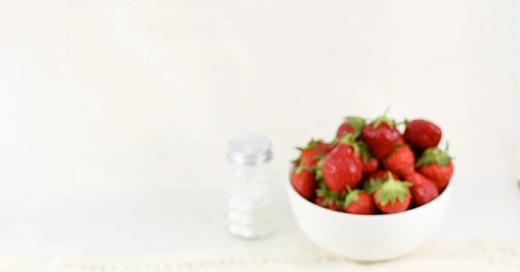








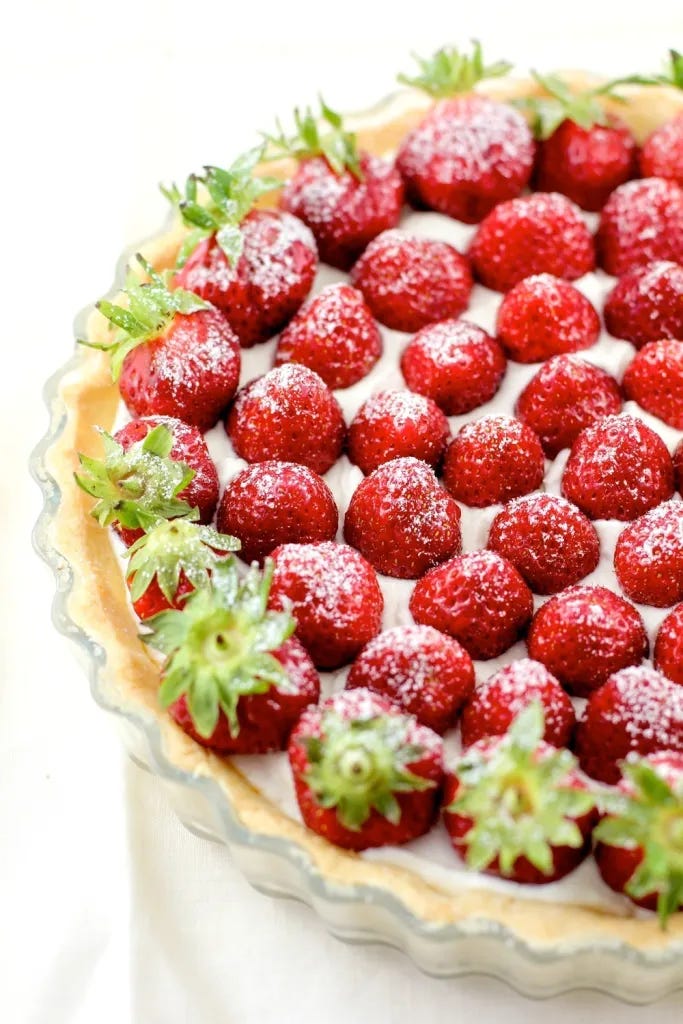
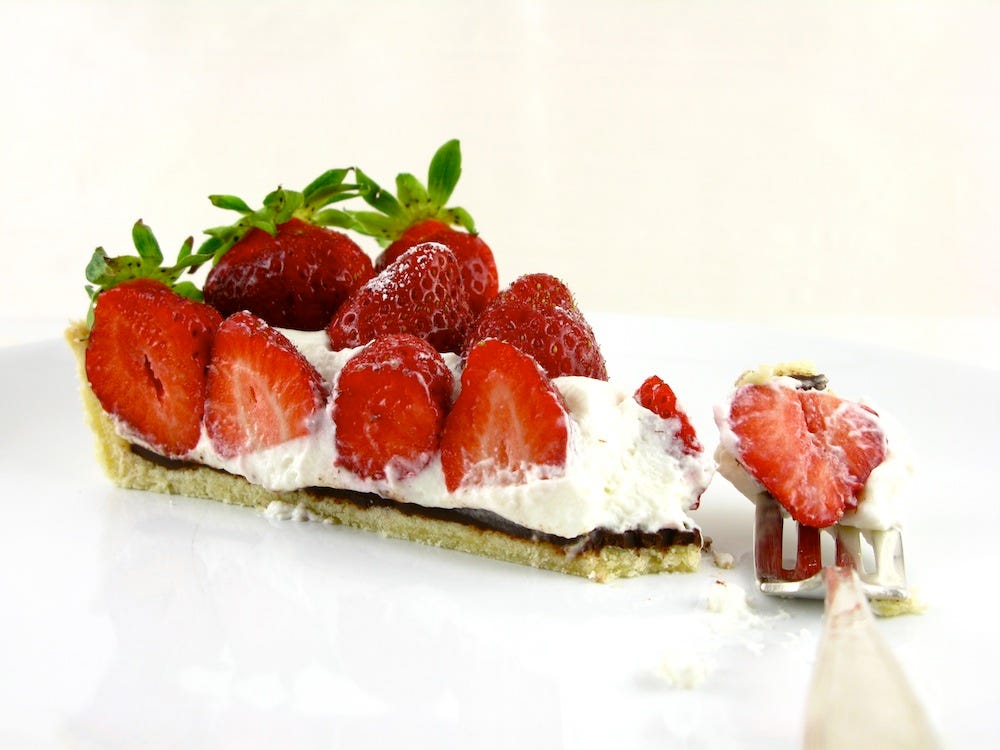
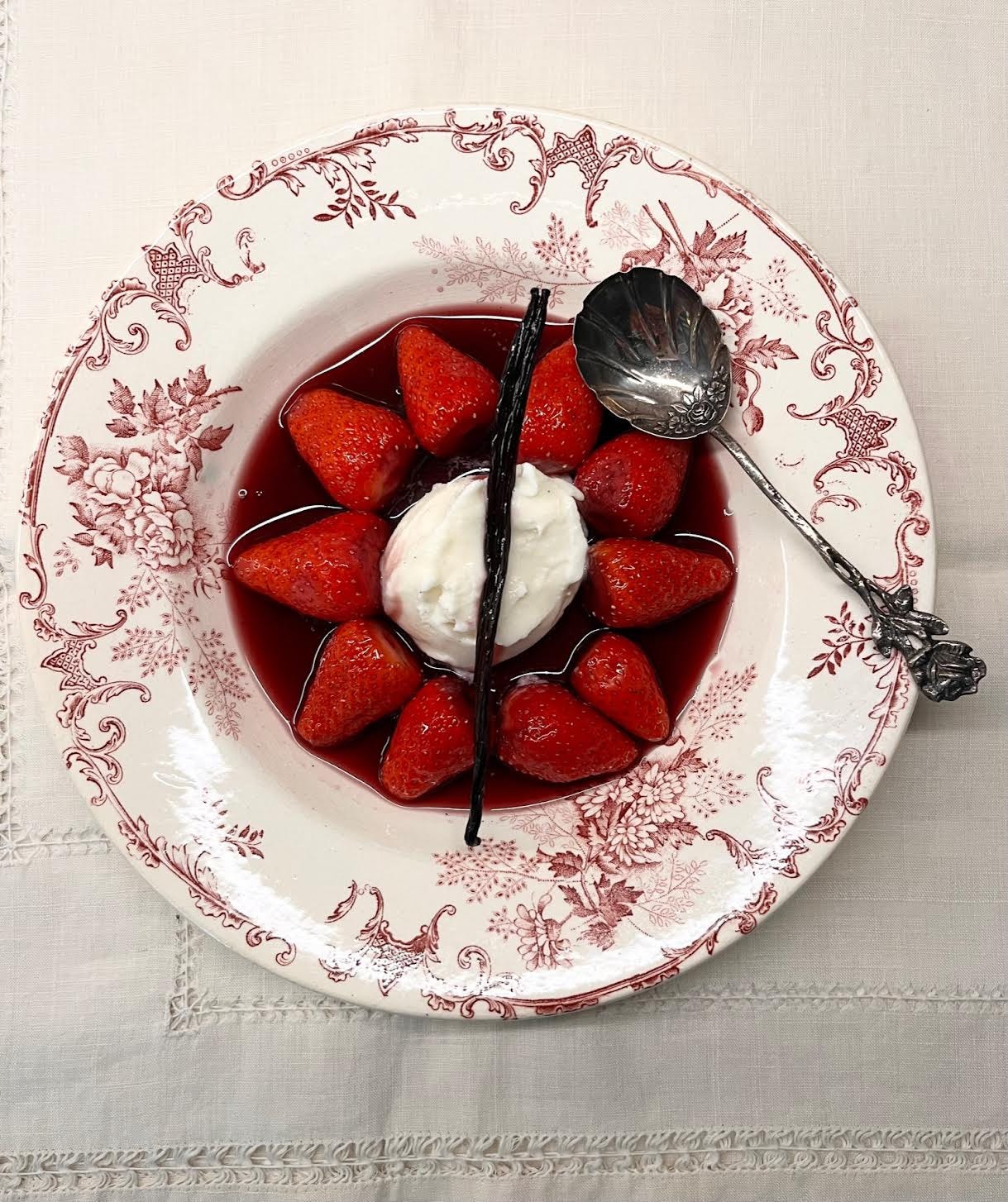
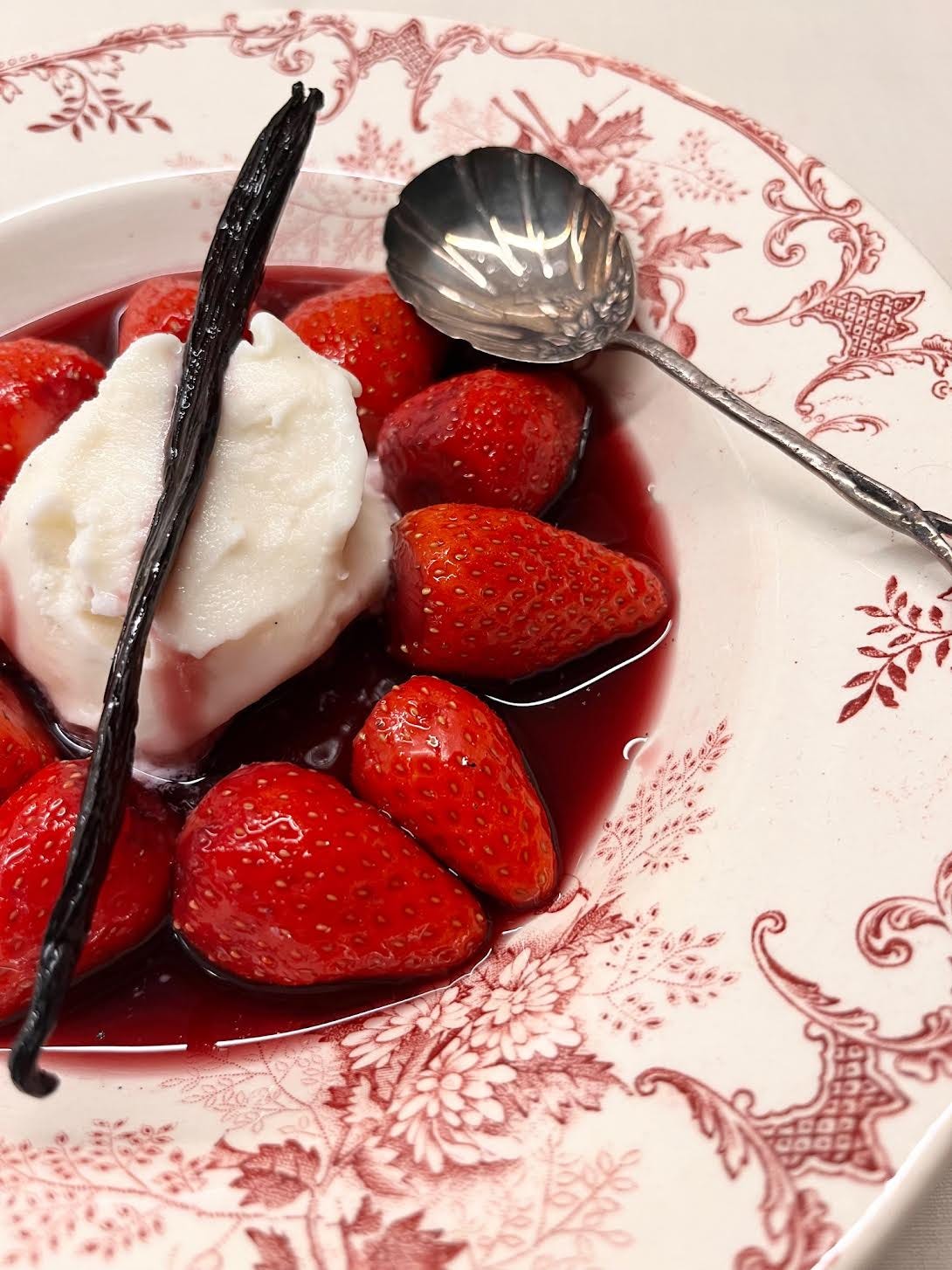
Your research is amazing. How many cookbooks (and related) do you own?
I really enjoyed this article- I love the history of food. Will be making the strawberry chocolate mint tart. Thank you! 💚